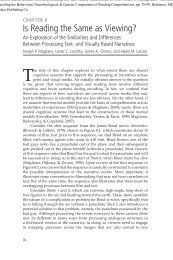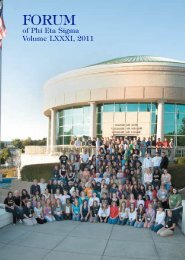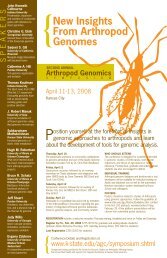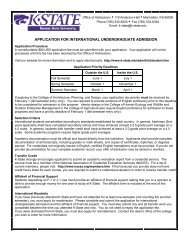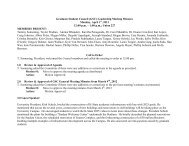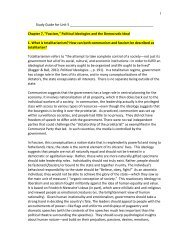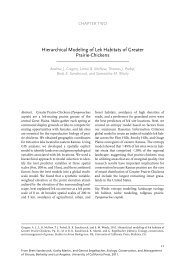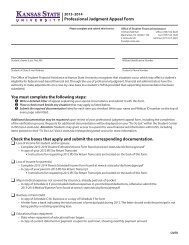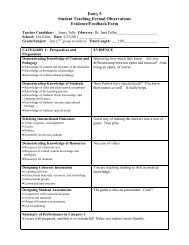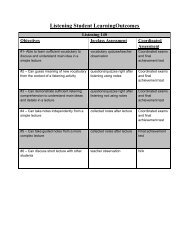Estimation of Demographic Parameters from Live ... - BioOne
Estimation of Demographic Parameters from Live ... - BioOne
Estimation of Demographic Parameters from Live ... - BioOne
You also want an ePaper? Increase the reach of your titles
YUMPU automatically turns print PDFs into web optimized ePapers that Google loves.
hummingbirds (Archilochus colubris; Hilton and Miller<br />
2003), songbirds (19 spp.; Johnston et al. 1997, Blake and<br />
Loiselle 2002, Cilimburg et al. 2002, Sandercock and<br />
Jaramillo 2002, Dugger et al. 2004), rodents (3 spp.; Lambin<br />
and Yoccuz 1998, Julliard et al. 1999, Kraus et al. 2005),<br />
pipistrelle bats (Pipistrellus pipistrellus; Sendor and Simon<br />
2003), seals (2 spp.; McMahon et al. 2003, Jessopp et al.<br />
2004), and ungulates (5 spp.; Loison et al. 1999). A general<br />
finding <strong>of</strong> these studies is that apparent survival rates are<br />
usually ranked: juveniles after first capture , adults after<br />
first capture , adults in subsequent intervals.<br />
In the special case where failure to encounter individuals<br />
after first marking likely is due to permanent emigration by<br />
transients, investigators can employ alternative methods.<br />
Some investigators have handled transience by developing a<br />
residency index based on the number <strong>of</strong> captures within a<br />
sampling occasion. Individuals captured once may be<br />
discarded or grouped as transients, whereas individuals<br />
captured 2 or more times are grouped as residents (Chase et<br />
al. 1997, Ward et al. 1997, Bayne and Hobson 2002,<br />
Cilimburg et al. 2002, Morrison et al. 2004, Ozgul et al.<br />
2004). This approach can be efficient if encounter rates are<br />
high, but a potential drawback is that observers may<br />
misclassify residents if they are captured only once.<br />
Transient models improve upon ad hoc approaches to<br />
dealing with transience by using a modified version <strong>of</strong> the<br />
time-since-marking models. The proportion <strong>of</strong> transients<br />
among unmarked individuals (s t ) at time t is estimated as ^s t<br />
2þ<br />
¼ 1 ^/1 t =^/ t , and s t appears as a term in the model<br />
notation (s t , / t , p t ; Pradel et al. 1997a). One potential pitfall<br />
<strong>of</strong> transient models is to misinterpret s t as the proportion <strong>of</strong><br />
the entire population that are transient. The parameter s t<br />
applies to newly marked individuals only, and the proportion<br />
<strong>of</strong> transients among this subset <strong>of</strong> the population can be<br />
estimated as T t ¼ ^s t N t /(N t þ m t ), where N t and m t are the<br />
numbers <strong>of</strong> newly marked and recaptured individuals at time<br />
t (Jessopp et al. 2004). <strong>Estimation</strong> <strong>of</strong> the proportion <strong>of</strong><br />
transients relative to the entire population is possible but<br />
requires a modified modeling approach (Oro et al. 2004).<br />
Empirical applications <strong>of</strong> the transient model have shown<br />
that a high proportion <strong>of</strong> transients may be a general feature<br />
<strong>of</strong> animal populations, including alpine newts (Triturus<br />
alpestris, ^s ¼ 0.43–0.48; Perret et al. 2003) and loggerhead<br />
sea turtles (Caretta caretta, ^s ¼ 0.19–0.68; Chaloupka and<br />
Limpus 2002). In birds, transients are a feature <strong>of</strong><br />
Swainson’s thrushes (Catharus ustulatus, ^s ¼ 0.56; Rosenberg<br />
et al. 1999), and other migrant songbirds captured at<br />
stopover sites (8 spp., ^s ¼ 0.49–0.79; DeSante et al. 1995).<br />
Investigators also have detected transients in at least 6<br />
populations <strong>of</strong> resident landbirds, including black-capped<br />
chickadees (Poecile atricapillus, ^s ¼ 0.27; Loery et al. 1997),<br />
serins (Serinus serinus; ^s ¼ 0.47–0.80; Conroy et al. 1999),<br />
Eurasian blackbirds (Turdus merula; ^s ¼ 0.57; Miller et al.<br />
2003), and other songbirds (3 spp., ^s ¼ 0.34–0.58; DeSante<br />
et al. 1995; 7 spp., ^s ¼ 0.04–0.68; Nott and DeSante 2002),<br />
and in 2 populations <strong>of</strong> colonial birds, including Audouin’s<br />
gull (Larus audouinii, ^s ¼ 0.08–0.14; Oro et al. 1999) and<br />
cliff swallows (Petrochelidon pyrrhonota, s not reported;<br />
Brown and Brown 2004). Comparisons <strong>of</strong> parameter<br />
estimates show that standard CJS models underestimate<br />
apparent survival if the proportion <strong>of</strong> transients is large<br />
(DeSante et al. 1995, Loery et al. 1997, Rosenberg et al.<br />
1999, Chaloupka and Limpus 2002).<br />
Overall, empirical applications <strong>of</strong> time-since-marking and<br />
transient models indicate that individuals not detected after<br />
the first capture occasion are a common feature <strong>of</strong> mark–<br />
recapture data for many wildlife populations. The ecological<br />
processes creating such encounter histories may be difficult<br />
to determine, but a prudent approach to analysis <strong>of</strong> CJS<br />
encounter histories would be to include time-since-marking<br />
or transience in any starting global model. If time-sincemarking<br />
models receive little support, investigators can<br />
always discard these candidate models later (e.g., Sandercock<br />
and Gratto-Trevor 1997, Sandercock et al. 2000).<br />
Where standard CJS models require 3 years <strong>of</strong> data,<br />
investigators need at least 4 years to estimate the extra<br />
parameters <strong>of</strong> the time-since-marking and transient models.<br />
Temporal Symmetry Models<br />
Encounter histories for temporal symmetry models are<br />
coded in the same format as CJS models (Fig. 1). Temporal<br />
symmetry models differ <strong>from</strong> standard CJS models in that<br />
investigators analyze the encounter histories simultaneously<br />
with both forward and reverse-time modeling (Pradel 1996,<br />
Franklin 2001, Nichols and Hines 2002). Forward-time<br />
modeling yields the usual estimates <strong>of</strong> apparent survival (/)<br />
and encounter rates (p). Reverse-time modeling <strong>of</strong> the same<br />
encounter histories <strong>from</strong> the last capture backwards yields a<br />
seniority probability (f), defined as the probability that an<br />
individual did not enter the population between the previous<br />
and current occasion. Forward-time modeling assumes<br />
homogeneous capture probabilities among marked animals,<br />
but reverse-time modeling extends this assumption to both<br />
marked and unmarked individuals, a more difficult restriction<br />
to meet (Nichols et al. 2000). In the recruitment or f-<br />
parameterization <strong>of</strong> the temporal symmetry model (/ t , p t ,<br />
f t ), the parameters / and f are combined to estimate the per<br />
capita rate <strong>of</strong> recruitment ^f t ¼ ^/ t (1<br />
^ftþ1 )/^f tþ1 . In the k-<br />
parameterization (/ t , p t , k t ), the same 2 parameters are used<br />
to estimate the finite rate <strong>of</strong> population change ^k t ¼ ^/ t /^f tþ1 .<br />
Most available estimates <strong>of</strong> population change are based<br />
upon deterministic matrix models (^k p ), and estimates <strong>from</strong><br />
temporal symmetry models (^k r ) are a new development. When<br />
selecting a modeling approach, it is important to recognize<br />
that ^k p and ^k r have markedly different properties (Sandercock<br />
and Beissinger 2002). Where ^k p is the predicted rate <strong>of</strong><br />
change if a population is exposed to the same set <strong>of</strong><br />
demographic rates for an indefinite period, ^k r is a realized<br />
estimate <strong>of</strong> population change in past intervals. Moreover,<br />
^k p is a mathematical expectation that integrates across all<br />
age or stage classes in the matrix model, whereas ^k r is the<br />
rate <strong>of</strong> population change for the single age class included in<br />
the encounter histories (usually adults, Ozgul et al. 2006). If a<br />
population is at the stable age distribution, all age classes<br />
1508 The Journal <strong>of</strong> Wildlife Management 70(6)



